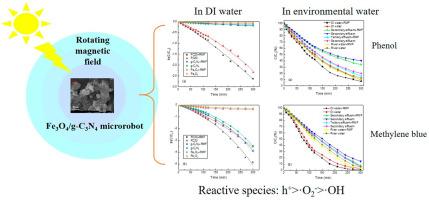A rotating magnetic field propelled photocatalytic Fe3O4/g-C3N4 microrobot for degrading phenol and methylene blue: kinetics, mechanisms, and effect of water matrices
IF 8.7
Q1 Environmental Science
引用次数: 0
Abstract
Graphitic carbon nitride (g-C3N4) has attracted widespread attention in the photocatalytic degradation of pollutants due to its unique thermal and physicochemical properties, whereas the low photocatalytic efficiency and difficulties in recycling limit its use. To improve the photodegradation of phenol and methylene blue in water, a new rotating magnetic field (RMF) propelled photocatalytic Fe3O4/g-C3N4 (FC) microrobot system has been created. The results demonstrated that the integration of RMF significantly enhanced the photocatalytic degradation of phenol and methylene blue by the Fe3O4/g-C3N4 microrobot. Under conditions of 1 g/L catalyst dosage and 2 A RMF excitation current, the Fe3O4/g-C3N4 microrobot with 20 % (w/w) Fe3O4 content (FC20) exhibited the highest photocatalytic activity, achieving 92.8 % degradation of phenol and >99.9 % degradation of methylene blue within 300 min. Furthermore, FC20 demonstrated excellent reusability, maintaining high degradation efficiency after four consecutive cycles. Factors such as magnetic induction, photocatalyst dosage, and pH were found to influence the degradation efficiency of phenol and methylene blue by Fe3O4/g-C3N4 microrobots. Additionally, the effects of inorganic ions and water matrices on the degradation of phenol and methylene blue were investigated. By studying the degradation mechanisms, it was revealed that the order of influence of reactive species during the photodegradation process was: h+>·O2−>·OH. In conclusion, the combined FC-RMF system has great potential for improving the removal of phenol and methylene blue pollutants from water.

旋转磁场推进光催化Fe3O4/g-C3N4微机器人降解苯酚和亚甲基蓝:动力学、机理和水基质的影响
石墨氮化碳(g-C3N4)由于其独特的热学和理化性质在光催化降解污染物方面受到广泛关注,但其光催化效率低、回收难等问题限制了其应用。为了提高水中苯酚和亚甲基蓝的光降解能力,建立了一种新型旋转磁场驱动的光催化Fe3O4/g-C3N4 (FC)微机器人系统。结果表明,RMF的集成显著增强了Fe3O4/g-C3N4微机器人对苯酚和亚甲基蓝的光催化降解。在催化剂用量为1 g/L、RMF激励电流为2 A的条件下,Fe3O4/g- c3n4微机器人的光催化活性最高,Fe3O4含量(FC20)为20% (w/w),在300 min内对苯酚的降解率为92.8%,对亚甲基蓝的降解率为99.9%。此外,FC20表现出良好的可重复使用性,在连续4次循环后仍保持较高的降解效率。研究了磁感应强度、光催化剂用量、pH等因素对Fe3O4/g-C3N4微机器人降解苯酚和亚甲基蓝效率的影响。此外,还研究了无机离子和水基质对苯酚和亚甲基蓝降解的影响。通过对降解机理的研究,发现光降解过程中反应物质的影响顺序为:h+>;·O2−>;·OH。综上所述,FC-RMF联合系统在提高水中苯酚和亚甲基蓝污染物的去除率方面具有很大的潜力。
本文章由计算机程序翻译,如有差异,请以英文原文为准。
求助全文
约1分钟内获得全文
求助全文
来源期刊

Water Cycle
Engineering-Engineering (miscellaneous)
CiteScore
9.20
自引率
0.00%
发文量
20
审稿时长
45 days
 求助内容:
求助内容: 应助结果提醒方式:
应助结果提醒方式:


